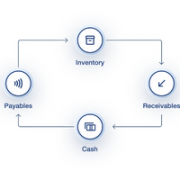Blockchain for trade finance: A network business
| 19-06-2018 | Carlo de Meijer | TreasuryXL

Trade finance has become one of the top focus issues for blockchain technology use. The number of pilots and other trials that are looking into the opportunities of blockchain technology for trade finance and supply chain have dramatically increased in 2017 and intensified this year. The sheer complexity of trade finance is thereby reflected in the variety of potential solutions. Different parts of the ‘trade finance supply chain’ had their own blockchain initiative. A large number of these pilots however stopped or failed being too narrow in their set-up. These were mainly focused on certain – and limited – aspects of the trade finance chain.
The various parties who are involved in the trade finance and supply chain business however are increasingly becoming aware that stand-alone solutions are not the answer to the various challenges in the trade finance industry. The success of using blockchain in trade finance purposes stands or falls with networks effects and if it is adopted widely. They are increasingly convinced that as well as developing a platform and blockchain solution, a network must be in place that covers all the parties in the trade finance chain so that the full transaction can be completed on the blockchain.
As a result we have seen the upcoming of blockchain trade finance networks with exotic names like Batavia, Marco Polo, We.Trade and more are expected to follow. In this blog I want to go somewhat deeper in these various offerings.
Trade finance: a complex process
Trade finance is a complex process. Various parties from exporters, importers, banks, truckers, shippers, custom agents and regulators all require checks and verifications at various points along the chain. Each interlocking part of the chain depends on successful completion of the previous phase and on reliable information.
Banks thereby play a large role in the trade finance chain, notably in the supply of letters of credit and other financing mechanism. Letters of credit are the most widely used way of financing between importers and exporters, helping guarantee trade transactions. At the moment buyers and suppliers use a letter of credit typically concluded by physically transferring paper documents to underpin transactions. This process however creates a long paper trail and it may take between five and ten days to exchange documentation.
A network business
Trade finance is a network business. It is an activity that often involves multiple counterparties in various and far-away parts of the world. Creating a blockchain trade finance ecosystem that combines all the different stages of trade from production to end-delivery is a must. For blockchain trade finance platforms to work in an optimal way this means on-boarding other banks, regulators, customs and all parts of the trade cycle. This asks for the setting up of blockchain-enabled trade finance platforms or networks with common standards enabling interoperability.
“Of course we are closely monitoring initiatives among all the other consortia that we know about developing trade finance on blockchain and we are mindful of ensuring inter-operability where we can”. Hubert Benoot, Head of Trade KBC and chairman of We.Trade
Read the full article of our expert Carlo de Meijer on LinkedIn

Economist and researcher









